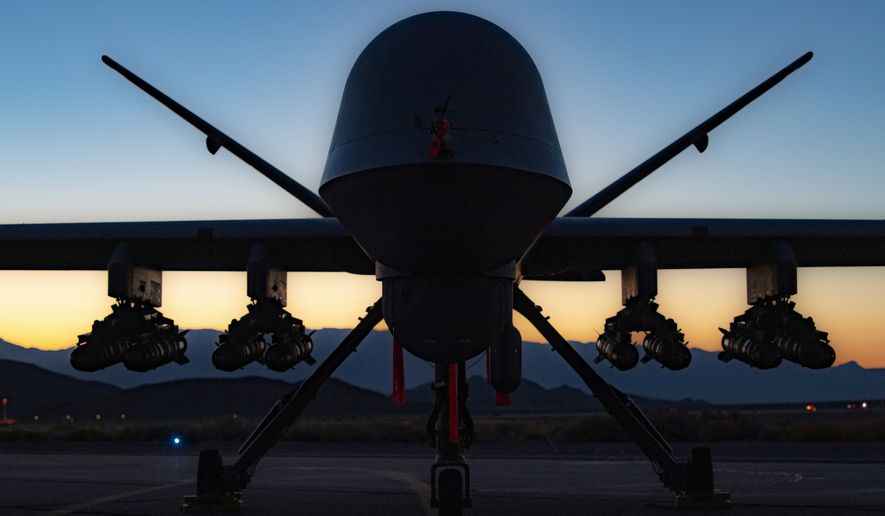In the military arms race between armed drones and anti-drone technology, the U.S. Air Force has enlisted a mystical, hammer-wielding Norse god for the fight.
The mythical Thor used his mighty war hammer, Mjolnir, to summon lightning and vanquish cinematic villains. The Air Force says its weapon of the same name can defend troops against the increasing threat of drone swarm attacks.
Mjolnir, pronounced “Me-yol-neer,” is the latest version of a cutting-edge weapon system called THOR — Tactical High Power Operational Responder — which marks the latest phase in the fast-evolving era of drone warfare. The Pentagon once had a near monopoly on unmanned aerial vehicles, but armies and even nonstate terrorist groups around the world now can deploy inexpensive, deadly drones on the battlefield.
Mjolnir’s high-powered microwaves can scramble internal circuitry, neutralizing entire flocks of UAVs by disorienting them. The approach sidesteps the need to knock every hostile drone out of the sky.
U.S. military planners have used drones for offensive and defensive maneuvers. THOR was designed to protect U.S. troops who may come under attack by large numbers of enemy UAVs.
Air Force officials expressed satisfaction with an early test of THOR’s capabilities at an undisclosed location in Africa at the end of last year. The system was set up to simulate the protection of a land base that could be vulnerable to drones and cruise missiles.
“Because THOR was so successful, we wanted to keep the new system’s name in the THOR family,” said Amber Anderson, a program manager at the Air Force Research Laboratory.
The idea behind swarm attacks is to overwhelm defenses. Iran and its proxies are increasingly using drones, many of them small, to strike U.S. and allied targets at sea and on land.
Marine Corps Gen. Kenneth F. McKenzie, commander of U.S. Central Command, has said drone attacks are threats that concern him the most. U.S. air defense systems can take out larger targets such as ballistic or cruise missiles, he said, but small drones are problems.
“The smaller drone is the future of warfare, and we need to get ahead of that right now,” Gen. McKenzie told Pentagon reporters in April.
Analysts say the July 29 drone attack on the Israeli-operated cargo ship MT Mercer Street that killed the captain and a crew member demonstrated the threat and the need to find a solution. The U.S., Israel and leading European nations said the evidence strongly pointed to Iran as the source of the drone, although Tehran denied any role.
“There is no justification for this attack, which follows a pattern of attacks and other belligerent behavior,” Secretary of State Antony Blinken said in a statement. “These actions threaten freedom of navigation through this crucial waterway, international shipping and commerce and the lives of those on the vessels involved.”
THOR and its offspring Mjolnir aren’t sleek like hypersonic missiles. The complete system is basically a 20-foot-long cargo crate with a satellite dish mounted on top. Still, it can take out a swarm of drones with a directed energy weapon to disable critical electronics. THOR and Mjolnir were engineered specifically to counter multiple targets “with rapid results,” Air Force officials said.
“The system output is powerful radio wave bursts, which offer a greater engagement range than bullets or nets,” Ms. Anderson said. “Its effects are silent and instantaneous.”
Air Force officials say they have learned a lot about anti-drone technology and how it can be improved.
“The Mjolnir prototype will use the same technology [as THOR] but will add important advances in capability, reliability and manufacturing readiness,” Ms. Anderson said.
The Air Force lab’s directed energy department is looking for partners to help develop the counterdrone weapon system. The goal is to produce large quantities of Mjolnir to maintain U.S. electromagnetic spectrum superiority and support a fledgling industry, officials said.
“As the danger from drone swarms evolves, all services are working closely to ensure emerging technologies like Mjolnir will be ready to support the needs of war fighters already engaged against these threats,” said Adrian Lucero, the deputy program manager for THOR.
Air Force officials expect delivery of the prototype weapon in 2023.
• Mike Glenn can be reached at mglenn@washingtontimes.com.




Please read our comment policy before commenting.